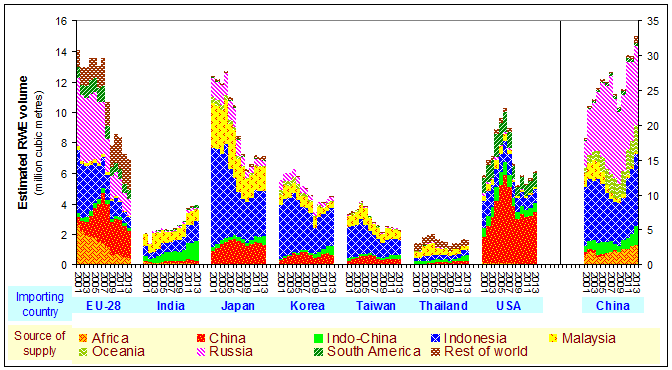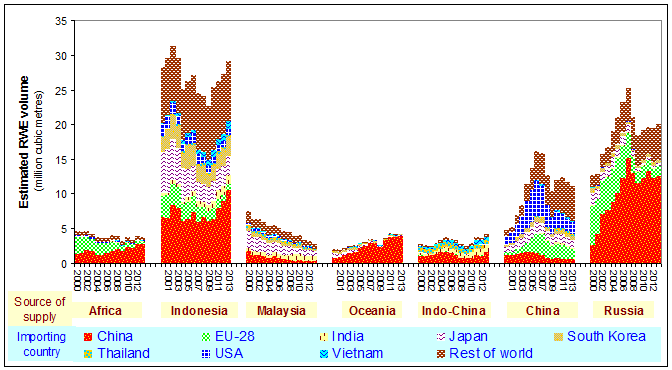|
World trade in illegal
wood-based products
Under construction
The following pair of charts
illustrate the relative scale of and trends in most trade in illegal
wood-based products. The scale and trends shown are unlikely to correlate
closely with production of illegal wood-based products for end-use
in countries of production.
Chart 1 - Imports of illegal
wood-based products

Chart 2- Exports of illegal wood-based
products

Chart 1 indicates that, during
recent years, China has probably imported a greater roundwood equivalent
("RWE") volume than the rest of the world combined. Chart
1 also indicates not only the extent to which trade declined during
the recession at the end of last decade but also the likely reality
that the impact of the amended Lacey Act and EC Regulation 995/2010
on the quantity of illegal trade has been indiscernible - except perhaps
in relation to the EU's imports. However, the trend shown merely reflects
the assumptions made in the evaluation. For example, the evaluation
assumes that most of the tropical timber which the EU imports from
Africa derives from FSC-certified forest and that this is legal. Chart
1 suggests that the EU's illegal imports are supplied primarily from
countries with which a VPA is unlikely to be established - China,
Russia, and some east European countries.
Chart 2 indicates that Indonesia
supplies a greater RWE volume of illegal wood-based products (primarily
as pulp and paper) than even China. However, China probably exports
rather more than any other country in terms of export value. Concerning
Indonesia, a number of the mills of the major producing groups were
cerified under what is now a discredited variant of the SVLK. There
has not been a formal, dissuasive, public process of forgiveness of
these groups (or any others) for the gross illegality and unsustainability
of their business, whether or not the illegality took place prior
to a "threshold" date (the FSC has adopted November 1994
as a threshold for certifying plantations if these have been established
on land which was forested until more recently than that date).
This - and increasing awareness
that illegal forest clearance accounts for much of the wood raw material
consumed in Indonesia (and eslewhere) - is not consistent with rhetoric
which suggests that Indonesia will soon be one of the first countries
to commence the routine supply of FLEGT-licenced products.
An Achilles Heel of the EU's FLEGT
Action Plan is its (arguably pragmatic) negligence of the well known
illegalities which take place prior to the allocation logging or clearance
rights. Those illegalities are fundamental to determining whether
production of palm oil, rubber, sugar, cattle products, soy, minerals,
etc on land which was cleared of forest in order to enable that production.
Amongst other things, this negligence tends to accelerate climate
change (directly through forest clearance and degradation, and indirectly
by minimising financial costs and maximising profits thus further
stimulating the paradigm of unsustainable growth and consumption and
delaying the sort of governance which must become established to equitably
change that paradigm).
Whereas the FLEGT Action Plan will
have facilitated changes in forest governance, it might be reasonable
to attribute significant changes in forest governance and related
trade to other intiatives, such as support for independent monitoring
and the response of some in the trade to central government procurement
policy (both of which predate the Action Plan), not to forget efforts
to segment the market more generally through certification and the
contribution of bilateral intitiatives from EU member states.
It might be premature to initiate
components of the Action Plan which depend on FLEGT-licensed products
being supplied in substantial quantity as a matter of routine until
there is much greater certainty that such supplies will take place
(with a credible licensing system).
The intent of EC Regulation 995/2010
was published more than four years ago. That regulation sets out to
provide greater incentive than available through a VPA alone for partner
countries to establish good governance in the supply of wood-based
products. However, there appears to be no attempt to use that regulation
in this manner - particularly in addressing the supply of illegal
wood-based raw material from VPA contries to maufacturing hubs in
third countries for subsequent export (including to the EU) or end-use
in that third country.
Given that China dominates the
production of illegal logs for export in many countries that are characterised
by poor governance, both in the tropics and elsewhere, imports from
China should be receiving much greater attention from Competent Authorities
in the EU member states which account for most of the RWE volume which
China exports to the EU. The UK imports a greater RWE volume of wood-based
products (and probably illegal wood-based products) from China than
any other EU member state, and should therefore take a lead in minimising
the EU's imports of illegal wood-based products from China.
|